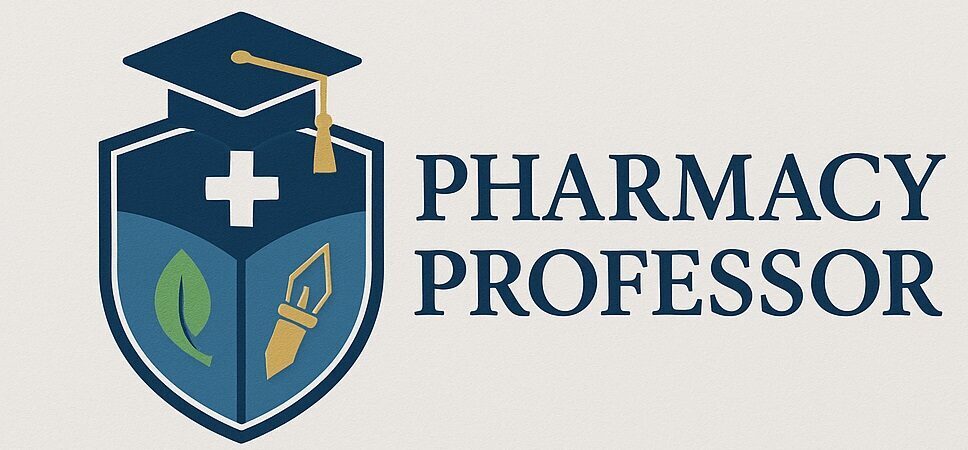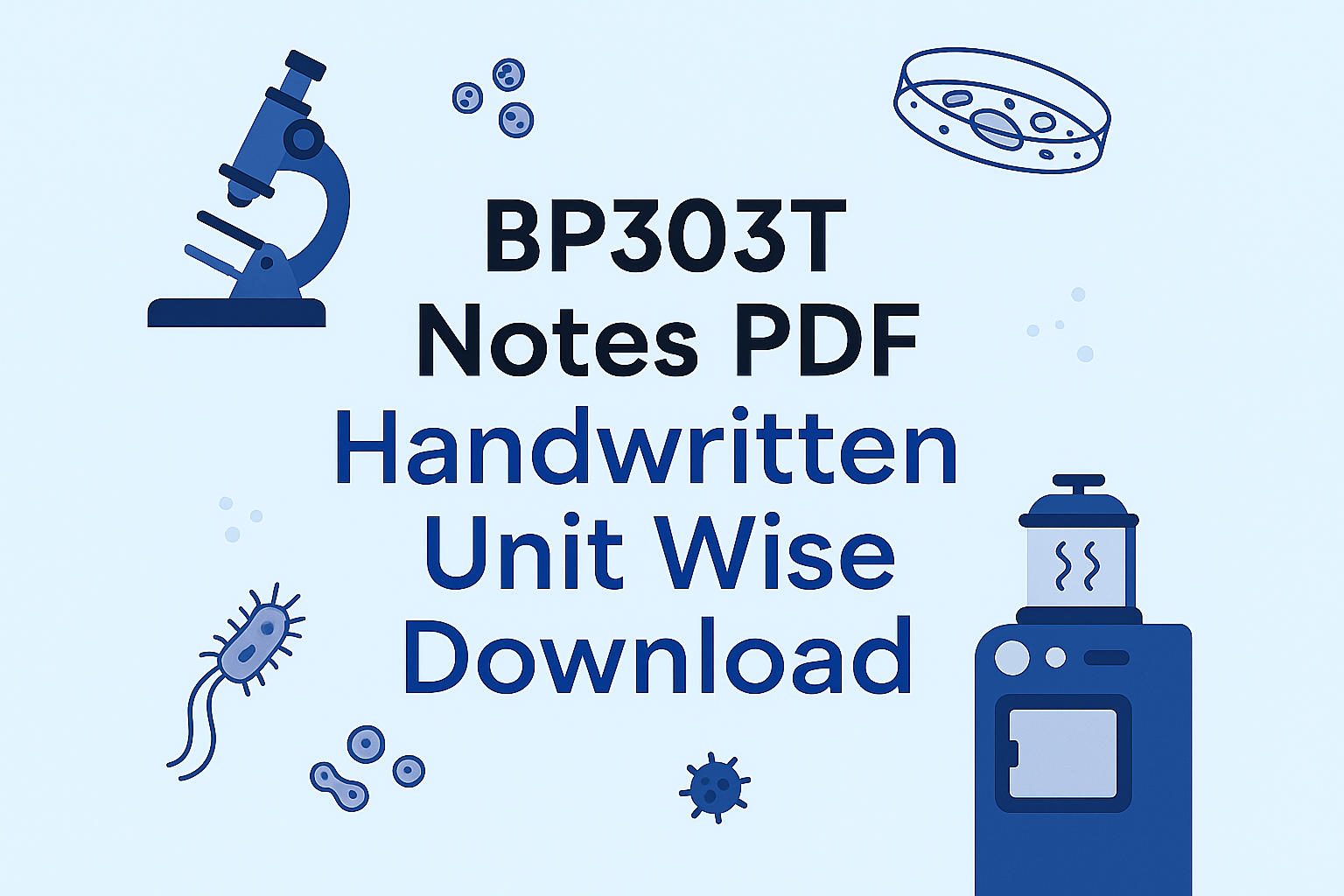Introduction
Are you a B.Pharm 2nd Year student struggling with BP303T Pharmaceutical Microbiology? You are not alone. This subject often feels difficult due to its scientific terminology and lab-based concepts. But don’t worry! We have compiled high-quality, unit-wise handwritten notes in PDF format that will help you prepare effectively for your exams. These notes are simple, well-organized, and aligned with the PCI syllabus.
What is BP303T – Pharmaceutical Microbiology?
Importance of the Subject
Pharmaceutical Microbiology is the study of microorganisms relevant to pharmacy. It deals with sterilization processes, microbial contamination, microbial testing, and aseptic techniques used in pharmaceutical manufacturing.
Learning Outcomes
- Identify, cultivate, and preserve various microorganisms used in pharmaceutical and laboratory settings through appropriate microbiological techniques.
- Understand the critical role of sterilization in pharmaceutical manufacturing, including the implementation of sterilization methods to ensure product safety and efficacy.
- Perform sterility testing of pharmaceutical products using standard protocols to evaluate microbial contamination.
- Conduct microbiological standardization of pharmaceutical substances, including antibiotic assay and microbial limit tests.
- Understand the principles of cell culture technology and explore its applications in drug development, vaccine production, and biotechnology industries.
Download BP303T Unit-Wise Notes PDF (Handwritten)
We have made it easy for you to download individual unit PDFs of BP303T notes. These handwritten notes are clear, concise, and exam-oriented.
Unit 1:
Introduction, history of microbiology, its branches, scope and its importance. Introduction to Prokaryotes and Eukaryotes Study of ultra-structure and morphological classification of bacteria, nutritional requirements, raw materials used for culture media and physical parameters for growth, growth curve, isolation and preservation methods for pure cultures, cultivation of anaerobes, quantitative measurement of bacterial growth (total & viable count). Study of different types of phase constrast microscopy, dark field microscopy and electron microscopy.
Unit 2:
Identification of bacteria using staining techniques (simple, Gram’s &Acid fast staining) and biochemical tests (IMViC). Study of principle, procedure, merits, demerits and applications of physical, chemical gaseous,radiation and mechanical method of sterilization. Evaluation of the efficiency of sterilization methods. Equipment’s employed in large scale sterilization. Sterility indicators
Unit 3:
Study of morphology, classification, reproduction/replication and cultivation of Fungi and Viruses.
Classification and mode of action of disinfectants Factors influencing disinfection, antiseptics and their evaluation. For bacteriostatic and bactericidal actions Evaluation of bactericidal & Bacteriostatic. Sterility testing of products (solids, liquids, ophthalmic and other sterile products) according to IP, BP and USP
Unit 4:
Designing of aseptic area, laminar flow equipments; study of different sources of contamination in an aseptic area and methods of prevention, clean area classification. Principles and methods of different microbiological assay. Methods for standardization of antibiotics, vitamins and amino acids. Assessment of a new antibiotic
Unit 5:
Types of spoilage, factors affecting the microbial spoilage of pharmaceutical products, sources and types of microbial contaminants, assessment of microbial contamination and spoilage. Preservation of pharmaceutical products using antimicrobial agents, evaluation of microbial stability of formulations. Growth of animal cells in culture, general procedure for cell culture, Primary, established and transformed cell cultures. Application of cell cultures in pharmaceutical industry and research
Advantages of These Notes:
- Based on the latest PCI syllabus ✅
- Handwritten and easy to understand format
- Focused on university exam questions and patterns
- Ideal for quick revision and last-minute preparation
- Helpful for viva voce and internal assessments
BP303T Syllabus Overview (PCI-Based)
| Unit | Topics Covered |
|---|---|
| Unit I | History of Microbiology, Microscopy Techniques, Staining Methods, Classification of Microorganisms |
| Unit II | Sterilization Techniques: Heat, Filtration, Radiation |
| Unit III | Cleanroom Design, Aseptic Area, Contamination Control, Laminar Flow |
| Unit IV | Microbial Assays, Limit Tests for Sterility, Pyrogen Testing |
| Unit V | Sterility Testing, Microbial Contamination Evaluation in Pharmaceuticals |
✍️ For detailed PCI structure, refer to the official PCI syllabus.
Recommended Books for BP303T Pharma Microbiology
- Prescott’s Microbiology – Standard reference for microbiological principles
- Pelczar’s Microbiology – Excellent for theory and scientific background
- Pharmaceutical Microbiology by Rawlins – Pharma-specific content ideal for BP303T
Exam Tips to Score High in BP303T
- Focus on important diagrams – microscopes, types of sterilizers, cleanroom layout
- Prepare concise short notes for definitions and key processes
- Revise using previous year university question papers
- Use these handwritten notes for a quick refresh before internal and final exams
📌 Related: Top Immunity-Boosting Superfoods for COVID-19 Patients in 2025
Sample Exam Questions from BP303T
Q3. What are microbial limit tests? Explain with examples.
Q1. Explain the principle and validation process of an autoclave.
Q2. Discuss various sterilization techniques used in pharmaceuticals.
Frequently Asked Questions (FAQs)
Q1. What is the syllabus of BP303T Pharma Microbiology?
The syllabus includes sterilization, microbial techniques, immunity, culture media, pharmaceutical microbiology, and microbial assays.
Q2. Where can I download BP303T Pharma Microbiology Notes PDF?
You can download free, unit-wise notes from PharmacyProfessor.com with simplified explanations and diagrams.
Q3. Are these BP303T notes enough for university exams?
Yes. The notes cover all units clearly and help in revision before internal and university exams.
Q4. Which book is best for BP303T Pharma Microbiology?
‘Pharmaceutical Microbiology’ by N.K. Jain or Prescott’s Microbiology are commonly recommended textbooks.
Q5. Are these notes useful for GPAT and competitive exams?
Yes. These notes include important topics and previous year questions helpful for GPAT and other pharma exams.
Q6. How many units are there in BP303T subject?
There are a total of five units in BP303T Pharma Microbiology as per PCI syllabus 2025.
Q7. Can I use these notes for B.Pharm Semester III study?
Absolutely. These notes are designed for Semester III B.Pharm students and follow the PCI guidelines.
Conclusion
Mastering BP303T Pharma Microbiology is crucial for every B.Pharm Semester III student. With concepts like sterilization, immunity, culture techniques, and microbial assays, it lays the foundation for pharmaceutical biotechnology and clinical microbiology. These easy, unit-wise notes will help you revise efficiently and perform better in internal and university exams.
For more helpful study material, check out our B.Pharm Semester-wise Notes Collection 📘 – it’s regularly updated with high-quality PDFs and exam tips.
Also, explore our guide on Top 10 High-Demand Courses After B.Pharm if you’re planning your career after graduation.
📺 Don’t forget to subscribe to our YouTube channel for video lectures, PYQs, and live discussions:
👉 Pharmacy Professor YouTube Channel


I want physical pharmaceutics 1 and pharmaceutical engineering and pharmaceutical organic chemistry 2 and pharmaceutical microbiology full notes
Please wait 3-5 days please visit again in same website